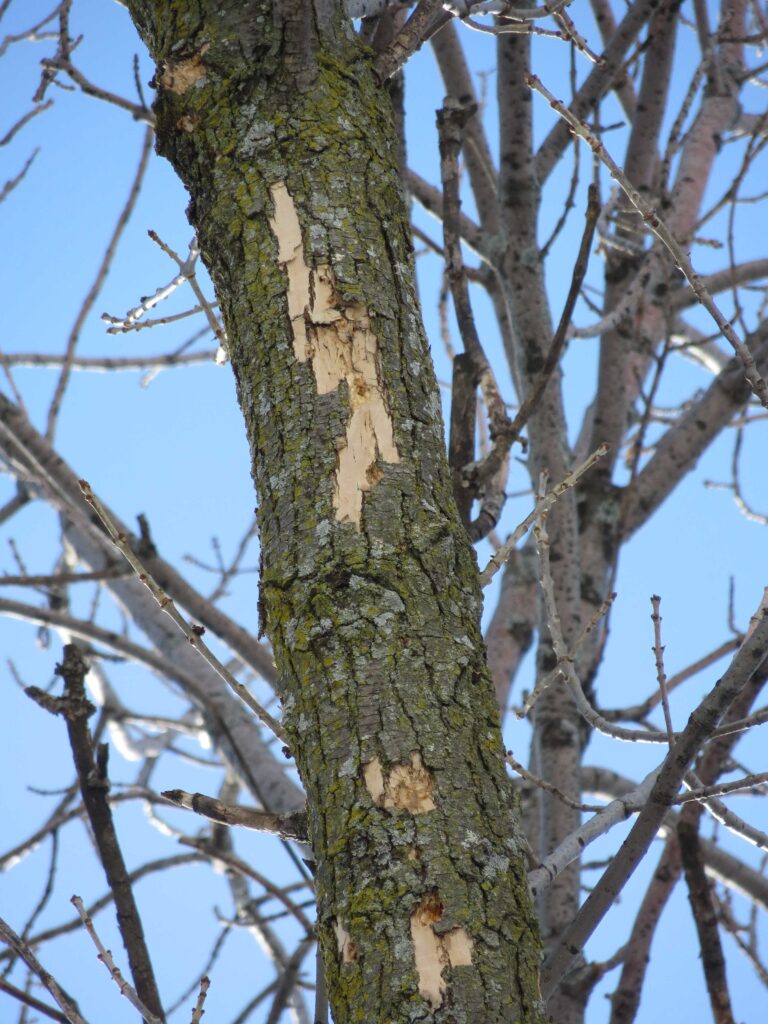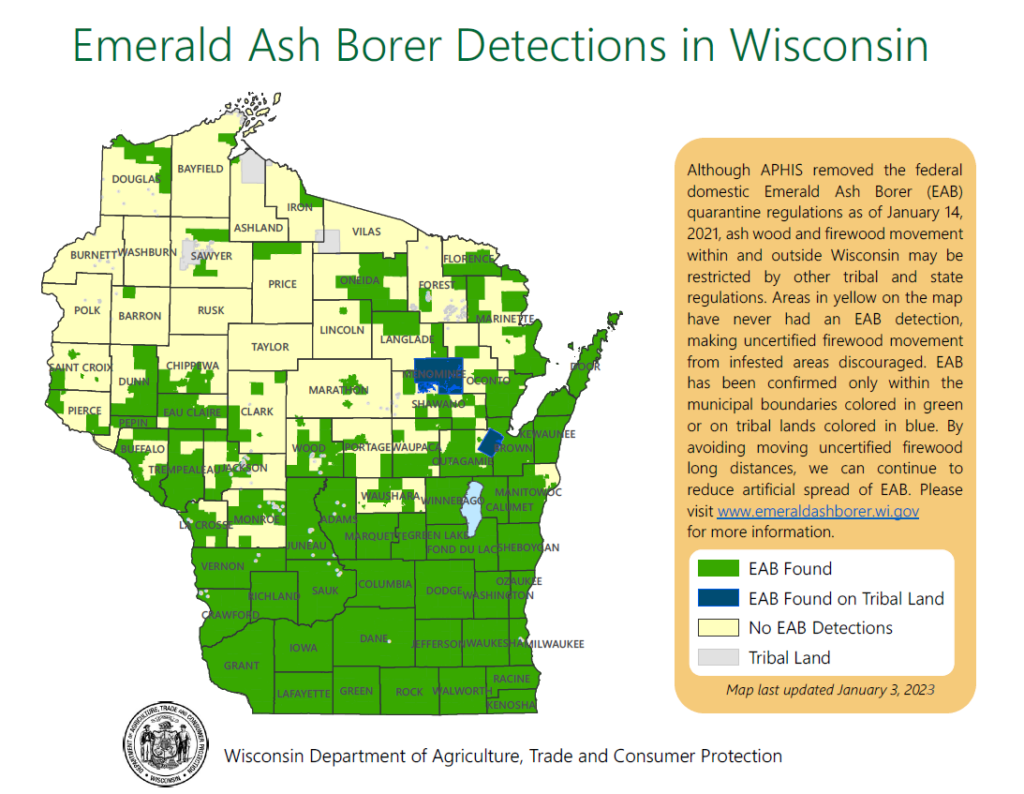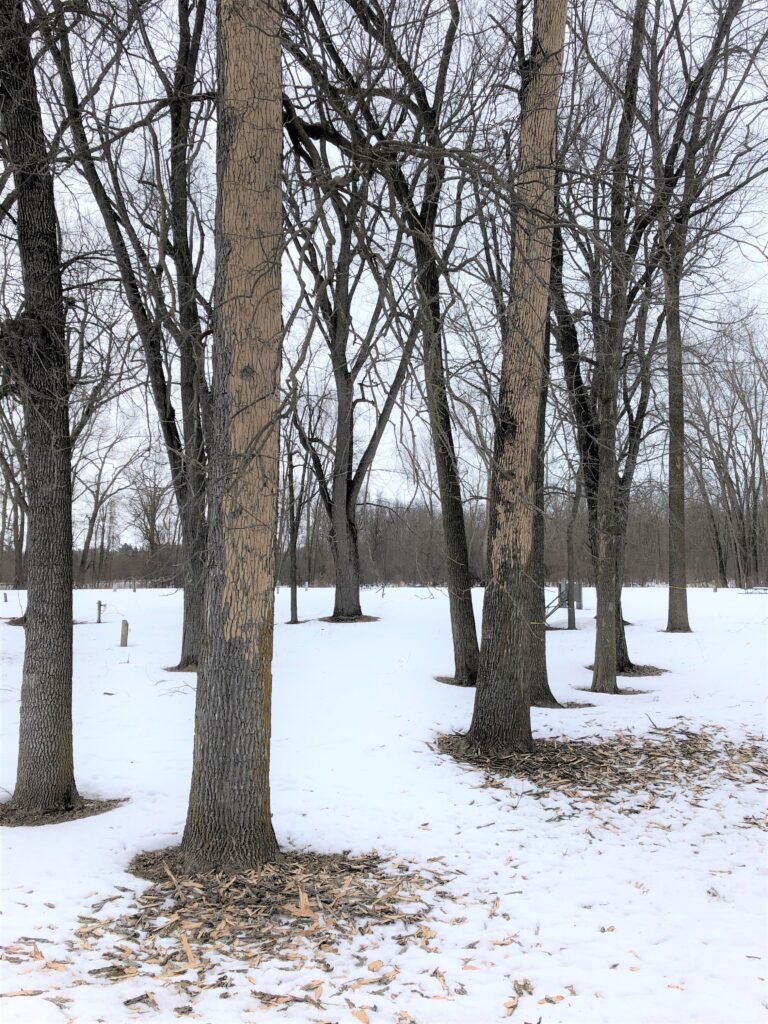By Bill McNee, Forest Health Specialist, Oshkosh, Bill.McNee@wisconsin.gov or 920-360-0942
Property owners with healthy, valuable ash trees are encouraged to treat them with insecticide this spring to protect against emerald ash borer (EAB). The pest is currently the most damaging threat to trees in Wisconsin, killing more than 99% of the ash trees it infests.
Woodpecker damage during the winter is often the first sign that an ash tree is infested. The birds remove pieces of bark while feeding on EAB larvae inside the tree. Insecticide treatment of infested ash trees is more likely to be successful if the trees have low or moderate levels of woodpecker damage.
Now is a good time to consider insecticide protection, because the treatments are typically done between mid-April and mid-May. Ash (in the genus Fraxinus) is the only type of tree that needs protection against EAB. Mountain ash and prickly ash do not need protection because the insect does not attack them.

This ash tree branch in West Allis has been damaged by woodpeckers feeding on EAB larvae beneath the bark.
Photo: Bill McNee, Wisconsin DNR.
EAB has now been detected in 66 of Wisconsin’s 72 counties. The southern half of Wisconsin is heavily infested, and EAB is now being found in an increasing number of locations in northern counties. The pest is so widespread that treatments are worth considering anywhere in Wisconsin. The highest risk of infestation is in communities already known to be infested or within 15 miles of a known infestation. The risk is lower elsewhere, but it is widely believed that there are additional undetected EAB infestations.

Municipal EAB detections as of January 2023 are shown in green.
Photo Credit: Wisconsin Department of Agriculture, Trade and Consumer Protection
Location isn’t the only consideration when deciding to treat. For example, the treatments are not economically practical for woodlot ash trees. Treatments also need to be repeated every one to three years or the trees will become heavily infested and die (the frequency of treatments will depend on the product and method used).
What You Should Do
Some insecticide products can be applied by homeowners, and others must be applied by a certified professional. Review the available options before selecting an insecticide and treatment method. Visit the Wisconsin EAB website and EAB Information Network website for more information about insecticides. Arranging for insecticide treatments ahead of time can secure an applicator, as well as avoid a last-minute rush when pesticide application businesses may already be very busy. Resources for finding a qualified pesticide applicator include the Wisconsin Arborist Association, International Society of Arboriculture and a local phone book.
Consider the following:
- Determine whether the tree is worth treating. Some ash trees are too heavily infested to save or have structural or health problems that make them unlikely candidates for insecticide treatment. Property owners may save money by removing an untreated ash tree before it becomes heavily infested.
- Trees with abundant woodpecker damage may be too infested for successful insecticide protection. Consult an arborist for a professional opinion.
- Landscape trees can improve views, increase property values, provide shade and cooling and contribute to the quality of life in a neighborhood. Weigh these benefits against the expense of insecticide treatments.
- Consider the cost of removing or replacing trees. You will often be able to treat your ash tree for a decade and spend less money than it would cost to remove that tree. Meanwhile, you get the benefits the tree provides.
- The cost of an insecticide treatment will depend on the tree size, product used and whether a professional is hired. Some products are applied annually, while others are applied every two or three years.
- Check the credentials and pesticide applicator certification of any business you hire to treat your ash trees.
- Unprotected ash that are dead or declining from EAB are often structurally weakened and present a safety hazard. These trees are also more hazardous to remove. Consult a tree care professional.
Signs And Symptoms Of An Infestation
Stay informed and be on the lookout for EAB. Know where the pest has already been found and look for the signs and symptoms of EAB infestation. Watch ash trees for the following:
- Woodpecker damage called “flecking,” where pieces of bark have been removed while feeding on EAB larvae beneath the bark. It usually starts up in the canopy and progresses down the tree over the next few years if the tree is not treated.
- Sprouts growing from the base or trunk of the tree.
- Thinning canopy with smaller, pale leaves.
- Small (one-eighth inch), D-shaped exit holes in the bark.
- Green beetles crawling on the trunk of ash trees during the summer.
Visit the DNR EAB webpage for more information.

Ash bark lies on the snow beneath heavily “flecked” ash trees at Sheboygan Marsh County Park.
Photo: Bill McNee, Wisconsin DNR.
